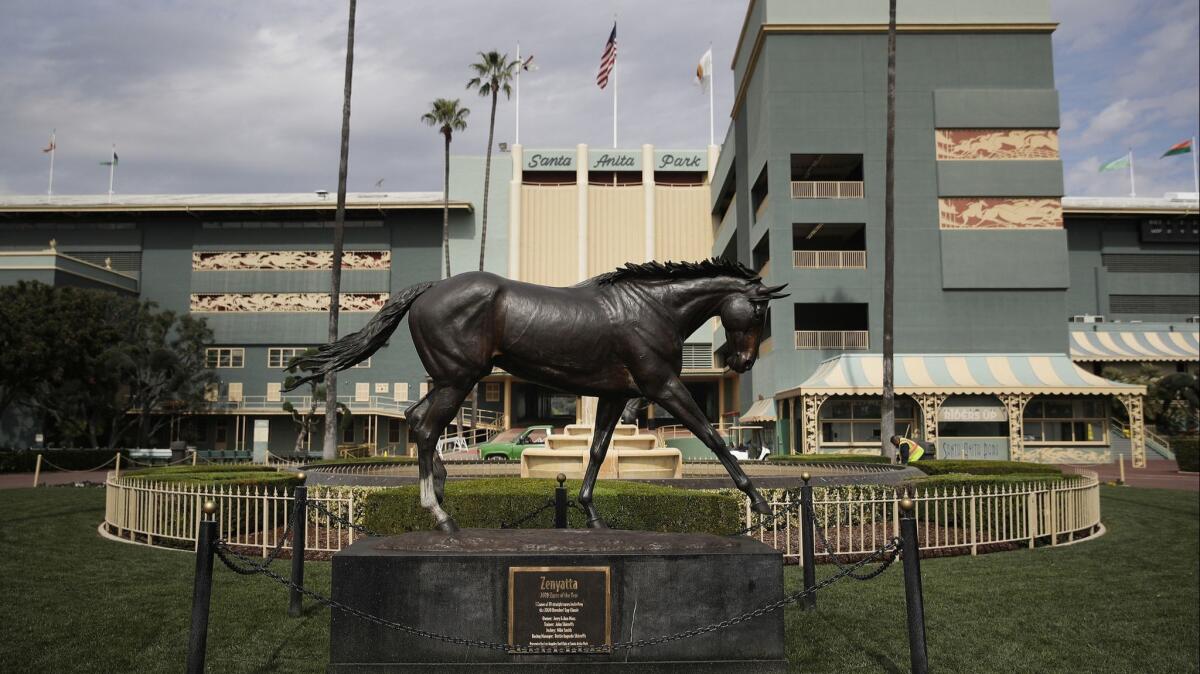Editorial: We are running out of ways to tell Santa Anita to stop racing

- Share via
On Saturday, a 4-year-old gelding named Formal Dude was euthanized after injuring itself during a race at Santa Anita Park. Formal Dude was the 28th horse to die from racing or training at the beleaguered track since December.
At that point, the California Horse Racing Board had had enough, and it took the extraordinary step of asking Santa Anita to suspend racing for the few days remaining in this season at the park.
But Santa Anita’s owners refused, and on Sunday the racing continued. That’s when a 3-year-old filly, Truffalino, collapsed and died just after the jockey pulled the horse out of a race. Truffalino became the 29th fatality of the season.
Frankly, we’re appalled. There have now been numerous calls for the Stronach Group, which owns the Santa Anita track, to suspend racing — from animal welfare groups and Sen. Dianne Feinstein (D-Calif.), among others. On May 29, this editorial board also called for a suspension.
In the last week alone, there have been three deaths.
All have urged the park to wait for the results from the official necropsies on these horses and an investigation into the mysterious spate of deaths that has bedeviled the Santa Anita track all year. It’s reckless enough to keep racing before the park has all the information it needs. But it’s disdainful and arrogant to do it in defiance of the state horse racing regulators.
It’s time to give the racing board the authority to compel a suspension. State Senate Bill 469 would, among other things, allow the board to suspend a track’s license to conduct horse racing when necessary to protect the health and safety of horses or riders. The bill should be approved. Furthermore, a congressional bill, HR 1754, the Horseracing Integrity Act, would establish some national oversight of a fragmented sport that is governed by different racing boards with different rules in every state. The congressional bill would ban race-day use of a common diuretic, Lasix, and establish a uniform medication control program to be developed and enforced by an independent authority.
There’s no question that Santa Anita has instituted some ground-breaking reforms governing the administration of drugs to horses on the track, and setting new rules for trainers and jockeys. After a spike in deaths from late December through March, the park closed for several weeks and put in place some of the new rules. After that, the park went six weeks with no deaths.
Then another rash of deaths began. Not all were broken legs. A couple were pelvic injuries. Some were what horse experts call rare or freak occurrences — such as shoulder injuries. Yet, two horses at the park suffered life-ending shoulder injuries in the last few weeks, making them seem less freakish. In the last week alone, there have been three deaths. But in a statement Sunday, the Stronach Group and the Thoroughbred Owners of California and the California Thoroughbred Trainers noted the drop in catastrophic injuries and reiterated that the reforms were working. The statement said that “the reality is that our improvements and changes have been effective.”
Enter the Fray: First takes on the news of the minute »
Really? Then why have we seen multiple deaths in a few weeks’ time? At this point, the park has six days of racing left in its season, which closes June 23. Then it returns in the fall for about a month and a half.
In calendar year 2018, according to statistics kept by the Jockey Club, Santa Anita’s rate of deaths per 1,000 “starts” (a horse literally starting a race) was 2.04. That’s substantially higher than last year’s national average of 1.68. It’s lower, though, than the alarming death rate of 2.73 at Churchill Downs in Louisville, Ky.
Over time, Americans have to decide how much death they are willing to tolerate in this ancient sport. More immediately, though, the owners of the track at Santa Anita have to face up to the troubling, unexplained deaths that have occurred this past year. And they should not risk any more horses’ lives for the rest of this season.
Follow the Opinion section on Twitter @latimesopinion or Facebook
More to Read
A cure for the common opinion
Get thought-provoking perspectives with our weekly newsletter.
You may occasionally receive promotional content from the Los Angeles Times.










